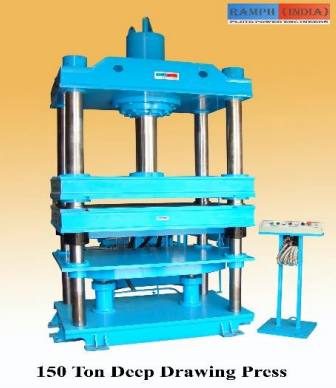Contact : +917338368993
Hydraulic Deep Drawing Press Manufacture
Introduction
Hydraulic deep drawing presses are essential machines in manufacturing, particularly in the metalworking industry. They are used to produce complex metal parts by applying high pressure to sheets of metal, forcing them into a die to create various shapes and components. The manufacture of hydraulic deep drawing presses involves a meticulous process that combines engineering precision, advanced technology, and rigorous quality control.
Design and Engineering
The first step in manufacturing a hydraulic deep drawing press is the design phase. Engineers and designers collaborate to create a machine that meets the specific needs of the application. Key factors include the press's capacity, stroke length, and the type of hydraulic system used. The design must ensure that the press can handle the required forces and dimensions while maintaining accuracy and reliability.
Computer-aided design (CAD) software is used to create detailed blueprints and simulations of the press. These designs are then subjected to various stress tests and simulations to ensure they can withstand the operational pressures and forces. The design also incorporates features for safety and ease of maintenance, such as automatic shutoff systems and accessible components.
Material Selection
The next phase involves selecting the appropriate materials for construction. High-strength steel is commonly used for the frame and structural components due to its durability and ability to withstand high pressures. For hydraulic systems, materials that can resist corrosion and high temperatures are chosen to ensure long-term performance.
Manufacturing Process
The manufacturing process of a hydraulic deep drawing press includes several key steps:
-
Fabrication: Large sheets of metal are cut, shaped, and welded to form the press's frame and main components. Advanced machinery, such as CNC machines and laser cutters, are employed to ensure precision in these parts.
-
Hydraulic System Assembly: The hydraulic system, which includes pumps, cylinders, and valves, is assembled and integrated into the press. This system is crucial for generating the high pressures needed for deep drawing operations. The hydraulic system must be tested rigorously to ensure there are no leaks and that it operates smoothly under load.
-
Component Installation: Once the main frame and hydraulic system are complete, other components such as the die sets, platens, and control panels are installed. The die sets are carefully aligned to ensure accurate forming of metal parts.
-
Calibration and Testing: After assembly, the press undergoes extensive calibration and testing. This includes checking the alignment of the dies, testing the hydraulic pressure, and ensuring that the press operates correctly at different speeds and pressures. The press is run through various test cycles to verify its performance and durability.
-
Finishing and Quality Control: The final steps involve finishing touches such as painting or coating to prevent rust and corrosion. Quality control inspectors conduct a thorough examination to ensure that the press meets all design specifications and safety standards.
Installation and Maintenance
Once the press is manufactured and tested, it is ready for installation at the client’s site. Professional technicians handle the installation process, ensuring that the press is set up correctly and calibrated for optimal performance.
Regular maintenance is crucial for the longevity of a hydraulic deep drawing press. This includes routine inspections, lubrication of moving parts, and replacement of worn components. Manufacturers often provide maintenance manuals and support services to help clients keep their presses in good working condition.
Conclusion
The manufacture of hydraulic deep drawing presses is a complex process that requires a blend of engineering expertise, advanced technology, and stringent quality control. From initial design to final testing, each step is crucial in ensuring that the press performs reliably and efficiently. As industries continue to demand more precision and capability, the manufacture of these presses will evolve, incorporating new technologies and materials to meet the ever-changing needs of the metalworking industry.
